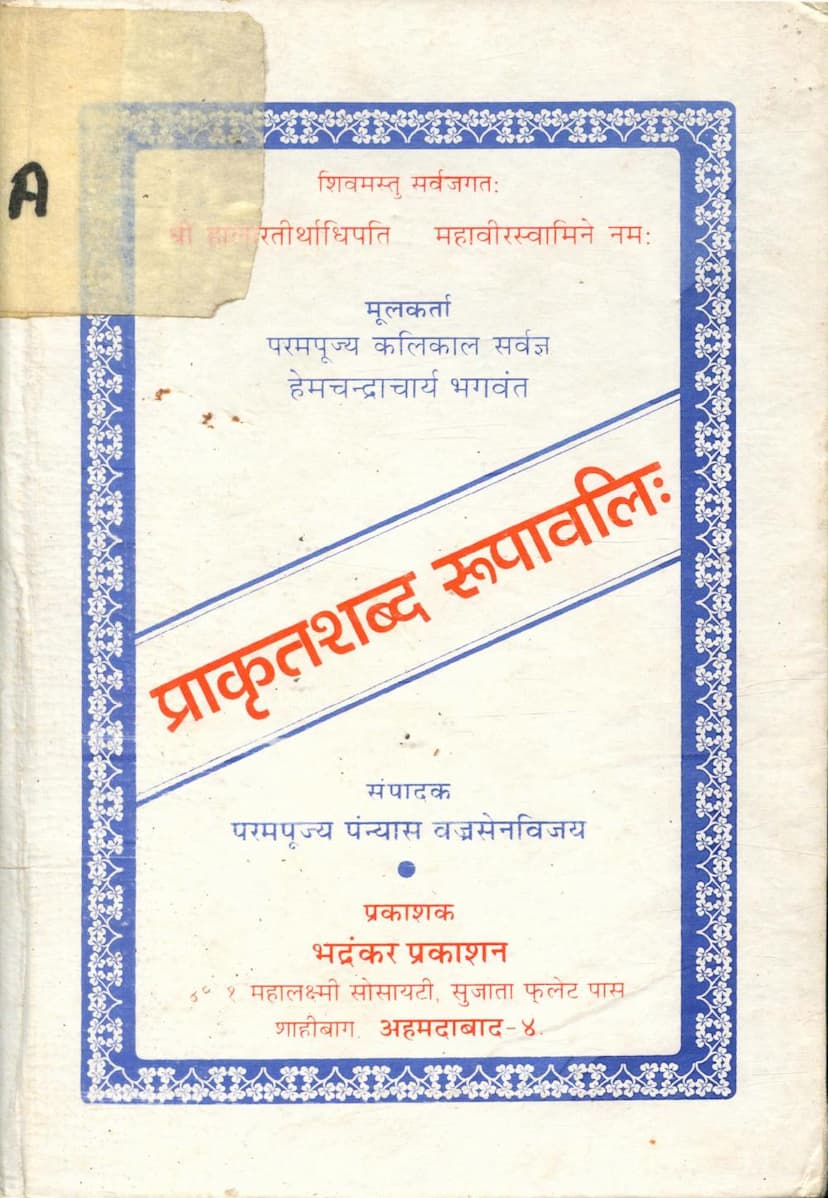Prakrit Shabda Rupavali
Added to library: September 2, 2025

Summary
Here's a comprehensive summary of the Jain text "Prakrit Shabda Rupavali":
Book Title: Prakrit Shabda Rupavali Author(s): Hemchandracharya, Vajrasenvijay Publisher: Bhadrankar Prakashan Catalog Link: https://jainqq.org/explore/004478/1
Core Purpose and Content:
"Prakrit Shabda Rupavali" is a compilation dedicated to the study of Prakrit grammar and vocabulary. It serves as a valuable resource for understanding the inflectional forms of Prakrit words, which are essential for comprehending various Jain scriptures, particularly those originally composed or predominantly written in Prakrit. The book aims to bridge the gap in knowledge regarding Prakrit language, which is noted as not being widely understood in the current era.
Key Figures and Contributions:
- Mool Karta (Original Author): Param Pujya Kalikāl Sarvajña Hemchandracharya Bhagavant. Hemchandracharya, a renowned scholar and the author of the seminal work "Siddh-Hem Shabda-shasana," is credited with the original foundational grammatical principles upon which this book is based.
- Sampadan (Editing and Compilation): Param Pujya Nyas Vajrasenvijay. Vajrasenvijay is credited with compiling and editing the "Prakrit Shabda Rupavali."
- Compilation Support: Param Pujya Shasan Samrat Acharya Dev Shrimad Vijay Nemisurishwarji Maharaj's disciple, Param Pujya Munivar Shri Pratapvijayji Maharaj, is credited with extracting the "Prakrit Shabda Rupavali" from the eighth chapter of Hemchandracharya's "Siddh-Hem Shabda-shasana," specifically the Prakrit section.
Historical Context and Revival:
The book was originally printed in Samvat 1968 (approximately 1911 CE) and had become scarce after 85 years. Recognizing its importance for scholars and religious figures, there was a demand for its re-publication. The current edition is a revival of this valuable text. Param Pujya Muniraj Shri Hunkarprabh Vijayji Maharaj initiated the re-publication, and despite his own ill health, Pandit Shri Vajrasenvijay Maharaj undertook the extensive task of editing and compiling it with the help of other esteemed individuals.
Structure and Methodology:
The book follows a systematic approach to presenting Prakrit word forms:
- Decline of Nouns (Shabda Rupavali): A significant portion of the book is dedicated to providing the declensions (inflectional forms in different cases and numbers) of numerous Prakrit nouns. It starts with common nouns like "Deva" (God) and then progresses to a wide array of other nouns, often categorized by their grammatical endings and phonetic properties.
- Sadhana Sutra (Grammatical Rules): Alongside the word forms, the text cites relevant grammatical rules (sutras) from the larger grammatical works, explaining the derivation and formation of these Prakrit inflections. This provides a scholarly foundation for the presented forms.
- Categorization: The words are presented in alphabetical order (or rather, in a systematic order based on phonetic or grammatical categories, often starting with common stems). This aids in systematic study.
- Examples: The book often provides examples of how Sanskrit and Gujarati words translate into Prakrit, and vice versa, further illuminating the linguistic connections.
Key Features and Content Areas:
- Extensive Vocabulary: The book covers a vast range of Prakrit words, demonstrating their various grammatical forms. This includes common nouns, abstract nouns, names of people, places, and concepts found in Jain literature.
- Grammatical Accuracy: By referencing the sutras, the book ensures the grammatical accuracy of the presented Prakrit forms, making it a reliable reference for students of Prakrit.
- Linguistic Bridge: The inclusion of translations between Sanskrit, Prakrit, and Gujarati highlights the evolution and relationships between these languages, which is particularly relevant in the context of Jain tradition.
- Correction and Refinement: The preface acknowledges the possibility of errors due to oversight or visual impairment and requests scholarly readers to correct and refine the text.
Target Audience and Significance:
"Prakrit Shabda Rupavali" is an indispensable tool for:
- Jain Scholars and Monks: Those studying Jain Agamas and philosophical texts written in Prakrit.
- Linguists: Researchers interested in the Prakrit language and its grammatical structure.
- Students of Jainism: Individuals seeking a deeper understanding of the language used in Jain tradition.
Overall Message:
The book represents a dedicated effort to preserve and disseminate knowledge of the Prakrit language, recognizing its profound importance in understanding the spiritual and philosophical heritage of Jainism. It is presented as a tribute to the scholarly contributions of Hemchandracharya and a testament to the dedication of the modern compilers and publishers in reviving and disseminating this essential linguistic resource.